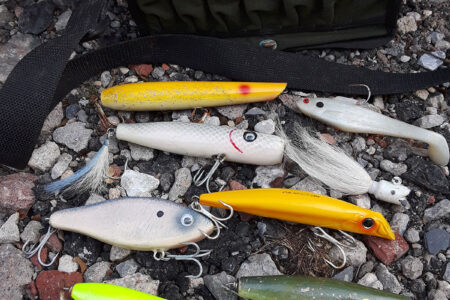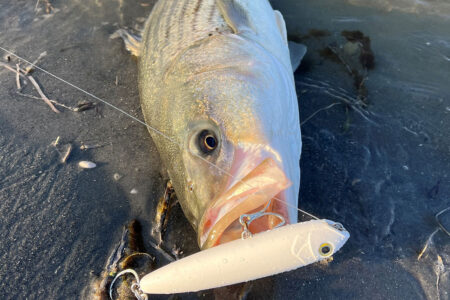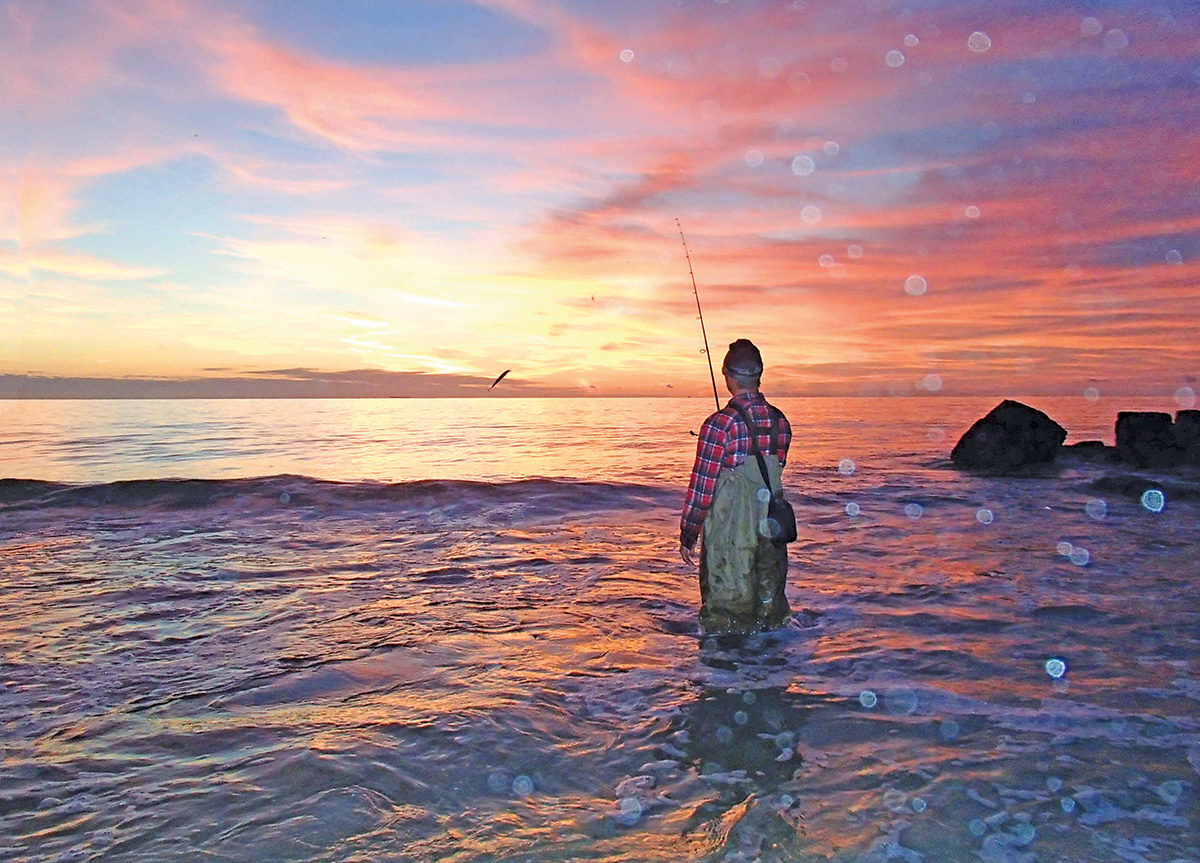
Understanding how and why to fish the inside pockets of jetties and inlet areas from the surf.
Twenty-five-knot southeast winds drove sleet into my face in 30-degree temperatures last year on December 12. Sunrise was nowhere to be found in the gray blanket that snuffed out any warmth in the pre-dawn hours. It wasn’t comfortable. As the onshore blow pushed the churning surf over the low tide bar and into the south pocket side of the jetty I was fishing, even before my first cast went plunking into the water I knew what the results were going to be. One, two, then 23 striped bass from 16 to 29 inches hit on nearly every cast of a Tsunami sand eel rubber bait. Those fish were stacked inside the pocket. This wasn’t the first day of that action, but the fourth consecutive day. Pocket pools are fish depositories.
Bait, Wind & Tide
Starting in September, the post summer switch flips on Labor Day, and the first tinge of autumnal air ushers in a new era of fall fishing. The drop in nightly air temperatures spark bait schools in the back bays to spill out of the inlets and stick in tight to the surfline. Mullet are number one on the list, and on good years, finger mullet can run through October, stacking up in the surf as they swim southward. Peanut bunker schools are commonplace as well and will continue to stay in the surf waters to well into November. Usually when the water drops into the 50s we see the presence of sand eels big time, which provide the main forage through December in local waters. There is always the possibility that round herring, Atlantic herring and even tinker mackerel will also push in during the autumn cool down.
What does it all mean? While we identify the baits that will choke up the surf waters, the next step is to understand how to intercept the schools as they get trapped alongside jetties and the inside pockets. The general idea here is that when you get a wind from a certain direction, you want to situate yourself to where the blow pushes directly into a jetty. Depending on where you sit along the coast, it could be a north, south or even easterly wind that pushes water up into the jetty, creating a deepwater pool that traps bait against the rocks. Those areas become jail cells for bait schools as they are pinned up and penned up and that’s pocket pool lesson number one.
Winds of 15 to 20 knots can be a very good friend of the surfcaster as it blows the water surface into a froth, pushing bait up tight against the jetty. High tides are optimal times to fish as heavier water will allow larger stripers and blues to come in to feed. Of course, low tide hours can be just as productive as the water thins out, leaving less room for the bait to escape between the jetty rocks and the sandbar on their way to freedom. Casts on high tides can be placed parallel to the jetty rocks, working the lure all the way back against the rocks. Low tide hours, focus on working near the jetty tips where pools form at the end right before the outer sand bar, leaving the baitfish with nowhere to go.
Castable Lures
Here’s where you need to make your selections the right way. Starting off in late summer and early fall, summer flounder will be found in those pocket pools and a go-to lure is a lighter 3/8- to half-ounce white bucktail tipped with a Berkley Gulp swimmin’ minnow grub with a bucktail hair or Gulp teaser tied ahead of it. Bounce the bucktail slowly alongside the rocks and don’t be afraid to walk 10 to 15 yards away as the pool will extend that far north or south of the cutout of the jetty before it shoals up again. Also work the ledge of the outside shoal of that pool for fluke.
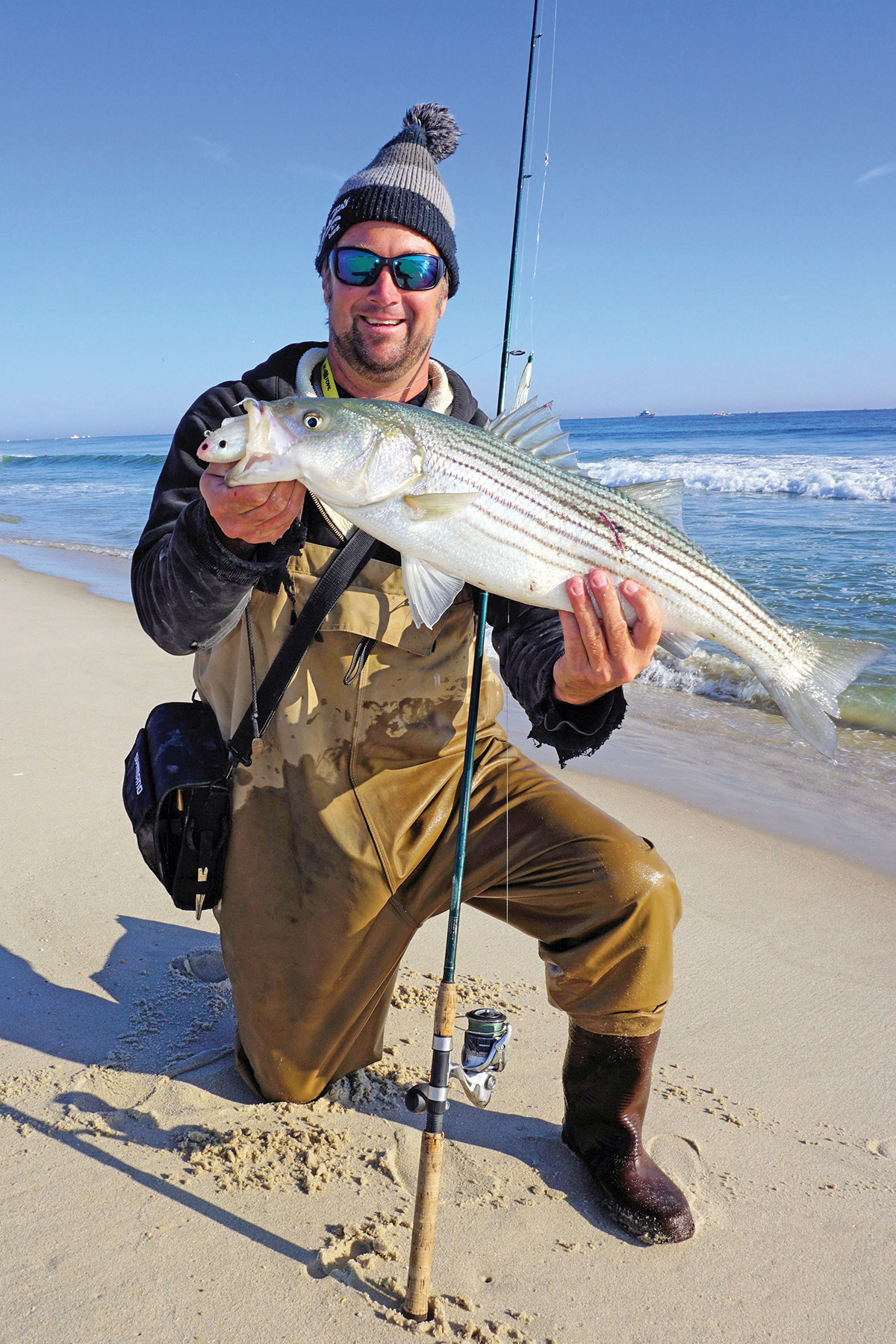
When the mullet run starts in earnest – hopefully by the middle of September – break out the Daiwa SP Minnows and old school Bomber A-Salt or 16 A plugs, Gibbs poppers and Stillwater Smack Its, again with a teaser ahead of them. Make parallel casts again, but also cast out to the outer sand bar alongside a jetty to find stripers and blues hanging and awaiting a free meal. When peanut bunker are predominant baits, switch up to Storm or Tsunami shads and cast accordingly.
During the late season in November and December when sand eels are around, it’s time to switch up to thin profile lures like Ava 007 jigs or the Tsunami sand eel. Drag those sand eel imitations close to the sea floor, reeling in a super slow pace.
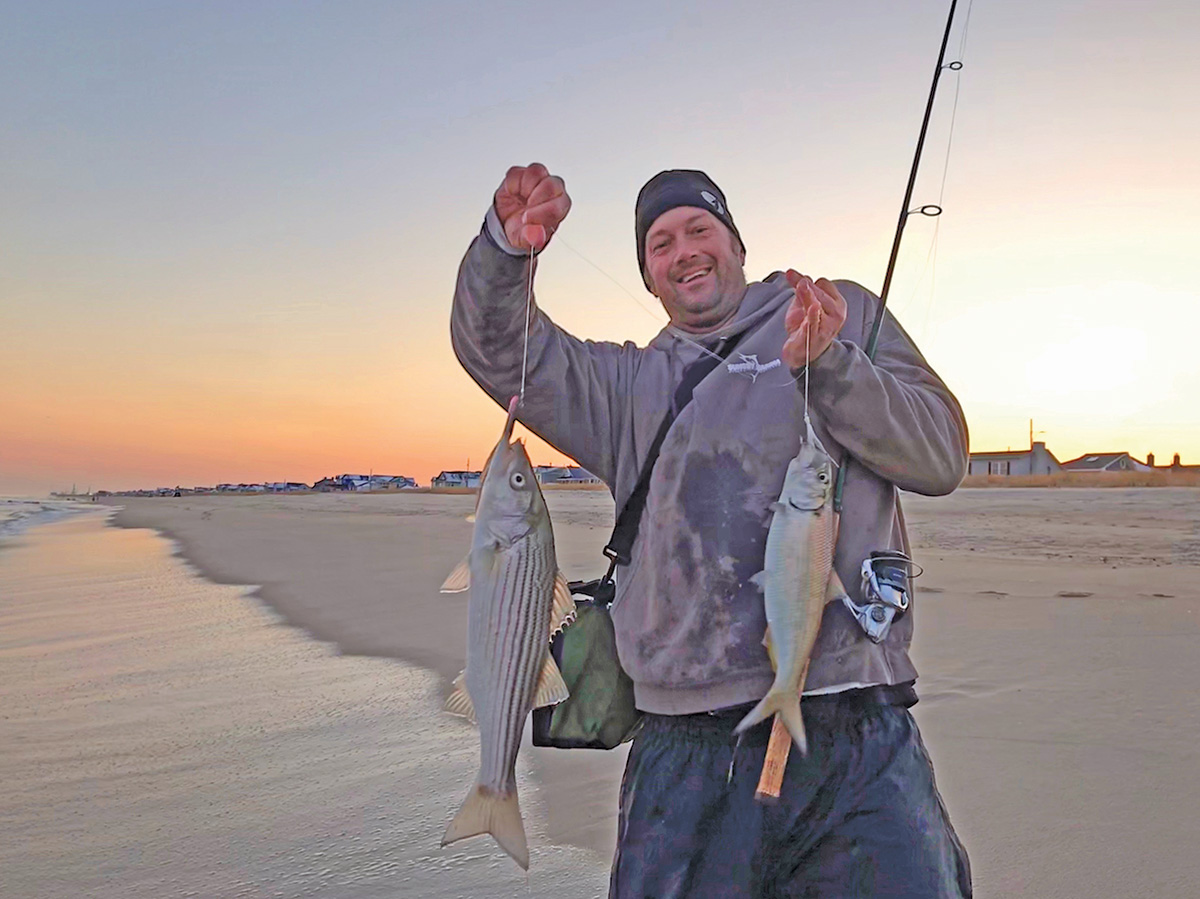
Theory in Practice
Even with beach replenishment, rock formations still exist or get uncovered along the Garden State shores during fall blows. Hot spots in the north include Asbury Park, Sea Bright and Deal for big popping bass. Inlet rocks at Shark River, Manasquan, Barnegat, Brigantine, Great Egg and Cape May, and jetty rocks in the Lavallette, LBI and Ocean City areas are all prime spots to search out.
Fall is the time of year to renew all your beach buggy permits as it helps greatly to be mobile to work jetties and find the pockets that are productive. Don’t be afraid to move around and hop the coastline, sometimes a 10-mile stretch during a day’s outing. Morning and evening hours are always prime, but the night shift can out-produce both of those times quite frequently, so be prepared with headlamps and an array of lures in your surf bag.
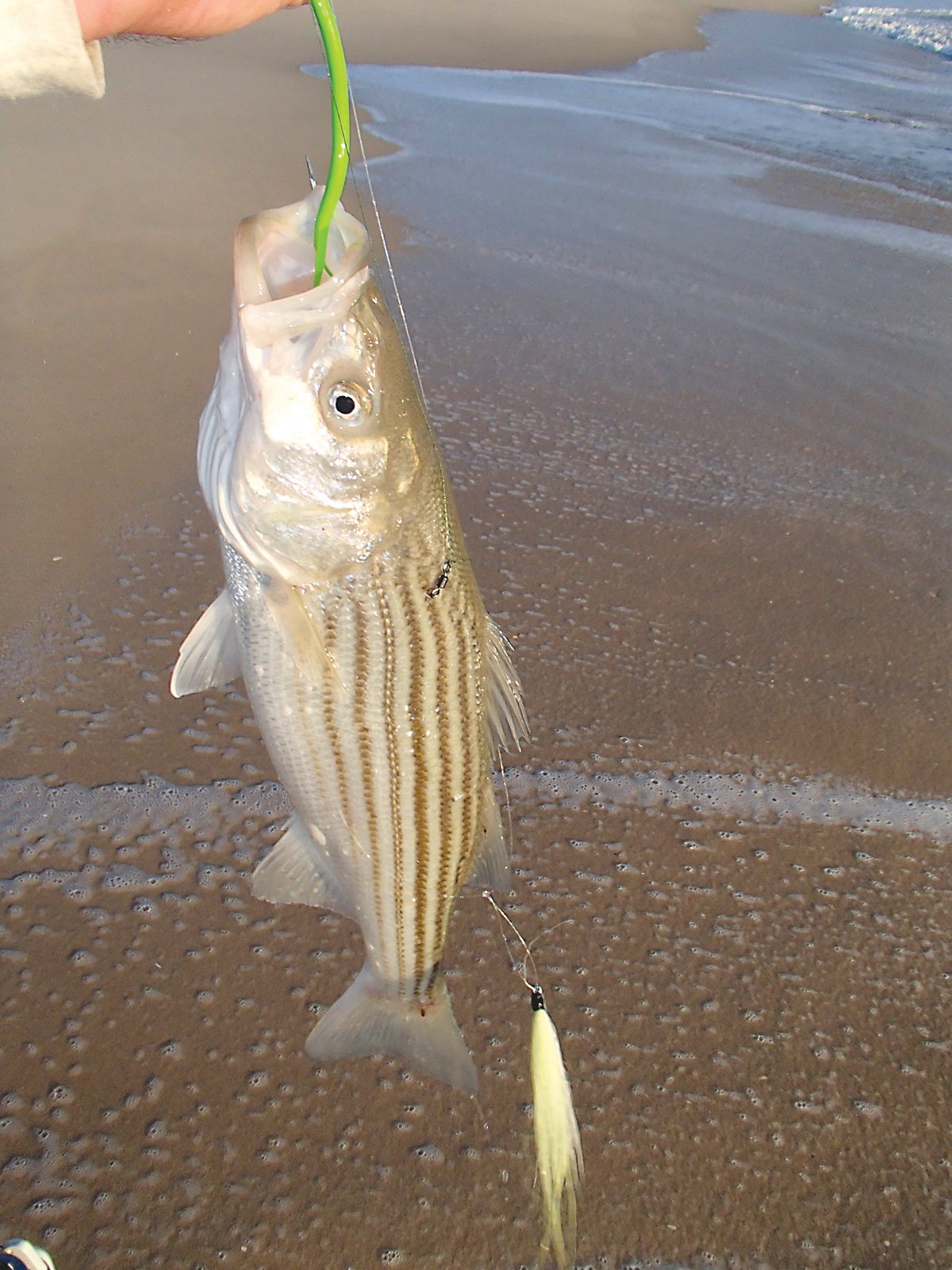
When you do find some action, note the time of day and the wind conditions, and I can almost guarantee if you find fish at a certain time and tide, you will catch at the exact spot again the next day. Case in point, last fall I worked a few jetties that didn’t give up many bass, but when I found a certain small pocket that produced, I hit it for four days straight at the same tide each day to pull 10 to 15 bass of it each outing, yet other spots were ghost. When it finally went dead, I simply moved down 3 miles and worked that area until I found another productive pocket pool that became the honey hole for a few days, and that process repeated through December.
Pocket pools are fish factories. When the bite gets going you can even break out the fly rod for tons of drag burning fun. Play your winds and tides right this year and jump on in for the pool party.

